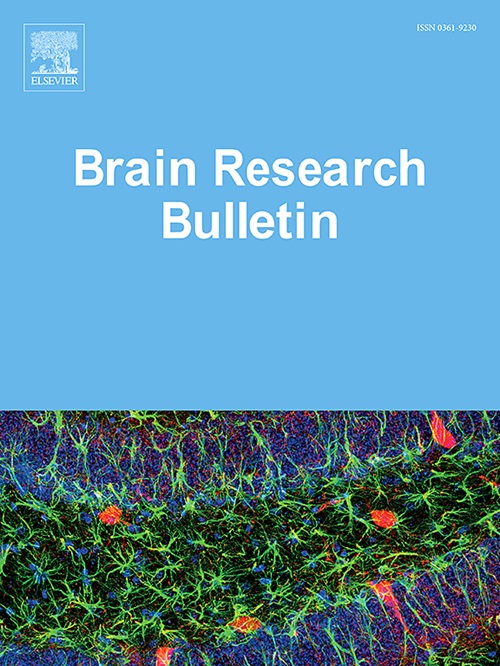趋化因子C-C基序配体2在健康猴和猴免疫缺陷病毒感染猴灰质/白质中的组织和细胞分布差异
IF 3.5
3区 医学
Q2 NEUROSCIENCES
引用次数: 0
摘要
先前的研究表明,脑脊液中的CCL2浓度高于健康人和人类免疫缺陷病毒(HIV)感染者的血浆,这表明CCL2在大脑中有额外的来源。脑细胞CCL2已在培养细胞中得到广泛研究,并在啮齿类动物实验性自身免疫性脑脊髓炎模型中研究了其在体内的细胞分布。然而,其在灰质和白质(GM, WM)中的细胞分布尚不清楚。我们用健康猴子和猴免疫缺陷病毒(SIV)感染的猴子进行了研究,发现:1)神经元是正常转基因动物ccl2样免疫反应(CCL2-ir)的主要来源,胼胝体(CC)室管膜显示高密度的CCL2-ir。2) SIV感染后,CCL2-ir在GM神经元和CC室管膜中显著升高。3)在正常GM和WM中,脑血管-血管周细胞是CCL2-ir的主要来源,而在CC-WM中,CCL2-ir在GM和CC-WM中相对较大。4)SIV感染后,GM和CC-WM中血管-血管周细胞的CCL2-ir比例面积显著增加。5)健康脑小胶质细胞似乎不表达CCL2。SIV感染后,小胶质细胞标记细胞和CCL2-ir共标记细胞显著增加。6)大量巨噬细胞样细胞沿感染的CC室管膜分布,提示大量单核细胞正在穿过室管膜,这可能与病毒库的建立有关。总之,我们的研究为正常和siv感染条件下猴子大脑中CCL2的细胞来源和改变提供了有价值的见解,这可能有助于更好地了解CCL2在相关神经过程中的作用。本文章由计算机程序翻译,如有差异,请以英文原文为准。
Differential tissue and cellular distribution of chemokine C-C motif ligand 2 in grey/white matters of healthy and simian immunodeficiency virus infected monkey
Previous studies have shown that CCL2 concentration is higher in cerebrospinal fluid than in plasma of health and human immunodeficiency virus (HIV) infected individuals, suggesting an extra source of CCL2 in brain. Brain cellular CCL2 has been broadly studied in cultured cells and its in-vivo cellular distribution has been investigated in rodent experimental autoimmune encephalomyelitis model. However, its cellular distribution in grey and white matter (GM, WM) remains elusive. We explored this issue using healthy and simian immunodeficiency virus (SIV) infected monkeys and found: 1) Neurons were a major source of CCL2-like immunoreactivity (CCL2-ir) in normal GM, and corpus callosum (CC) ependyma showed high density of CCL2-ir. 2) Upon SIV infection, CCL2-ir was strikingly raised in GM neurons, and in CC ependyma. 3) Brain vascular-perivascular cells were a large source of CCL2-ir in normal GM and WM, which was relatively larger in CC WM than in GM. 4) Vascular-perivascular CCL2-ir proportional areas were significantly enhanced by SIV infection in both GM and CC WM. 5) Microglia seemed not to express CCL2 in healthy brain. Microglia-marker and CCL2-ir co-labeled cells were significantly increased by SIV infection. 6) A vast of macrophage-like cells were situated along infected CC ependyma, suggesting a large number of monocytes be crossing ependyma, which may be related to establishment of viral reservoir. In conclusion, our study provides valuable insights into the cellular sources and alterations of CCL2 in the monkey brain under normal and SIV-infected conditions, which may promote better understanding of CCL2 in related neurological processes.
求助全文
通过发布文献求助,成功后即可免费获取论文全文。
去求助
来源期刊

Brain Research Bulletin
医学-神经科学
CiteScore
6.90
自引率
2.60%
发文量
253
审稿时长
67 days
期刊介绍:
The Brain Research Bulletin (BRB) aims to publish novel work that advances our knowledge of molecular and cellular mechanisms that underlie neural network properties associated with behavior, cognition and other brain functions during neurodevelopment and in the adult. Although clinical research is out of the Journal''s scope, the BRB also aims to publish translation research that provides insight into biological mechanisms and processes associated with neurodegeneration mechanisms, neurological diseases and neuropsychiatric disorders. The Journal is especially interested in research using novel methodologies, such as optogenetics, multielectrode array recordings and life imaging in wild-type and genetically-modified animal models, with the goal to advance our understanding of how neurons, glia and networks function in vivo.
 求助内容:
求助内容: 应助结果提醒方式:
应助结果提醒方式:


